There is no “typical” email user, and there is no “typical” burden of spam.
Spam places a real and uninvited burden on email users. To help assess that burden, we asked emailers how many emails they receive; how much of that incoming email is spam; and how much time they spend dealing with their spam.
About a quarter (23%) of emailers receive 5 or fewer emails a day, balanced by about that same number (27%) who receive more than 30 emails a day. The remaining emailers are fairly well distributed in between.5
How much of that email is spam? About a third of emailers found 25% or less of their inbox to be spam, another third found 60% or more to be spam, and the remainder lay somewhere in between.
How much time does this spam consume? More than a third of emailers (35%) spend just a few minutes a day on spam. Another 25% spend 5 to 14 minutes. Some 13% spend from a quarter up to a half hour. And 15% spend half an hour or more a day on spam.
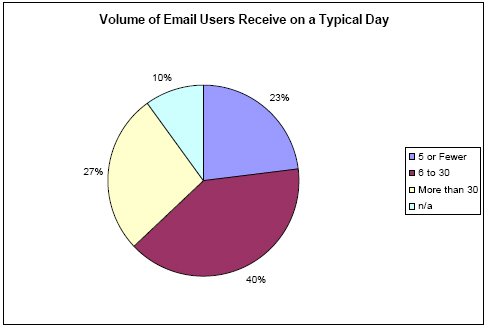
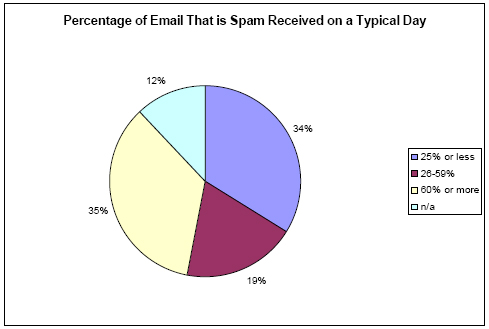
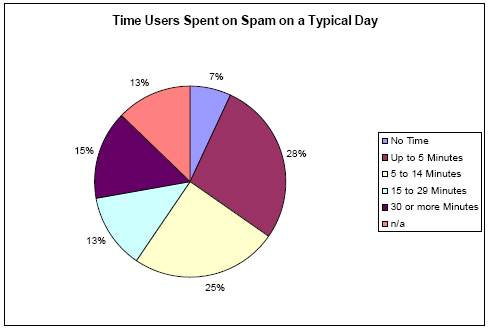
Spam comprises a relatively constant proportion of email received for every type of user.
We found no systematic correlation between the volume of email and the proportion of spam. That is, spam is a relatively constant proportion of the email most Internet users receive, regardless of their overall volume of email. However, there were exceptions at the polar ends of the scale. Those receiving the very fewest emails (5 or fewer) were most likely to receive no spam at all (16% reported they received no spam, compared to 7% of all users), and those who received the very most email (over 100) were most likely to receive the highest percentage of spam (39% reported that more than 80% of their emails were spam, compared to 19% of all users).
We found from the comments of emailers in the TRAC survey that the perception of the burden of spam was quite uniform, regardless of the actual numbers involved. That is, people are peeved by spam – whether they get a lot of it or a little.
Here are some typical TRAC responses:
- “Every time I try to check my messages, they are loaded with 95% or better pure spam or pornographic offers…. on one of my accounts, I had 1278 messages in one day. Can you imagine how much time it takes to delete that many?”
- “I get 20 – 30 emails a day, and out of that at least 12 will be unsolicited email…I am getting ready to cancel the Internet, unless something is done soon.”
And from another, who must be a record holder or an imaginative exaggerator: “I currently receive around 2,000,000 spam messages per month. Yes, really. I archive each of these messages (as I have for the past several years.) That means that I’m currently logging between 400 megabytes and 1 gigabyte of spam each day. It is truly a huge problem.”
But even those who receive a small amount of spam feel violated. One wrote: “I get 3 email spams **every** day of the week….I am nearly ready to close down all my email accounts after 8 years on the Internet. Spam has ruined the Internet.”
Spam is more of a problem for people in their personal email accounts than in their work email accounts.
The averages for email volume, percentage of spam, and time spent on spam become much more interesting and revealing when we separate the numbers to compare personal email and work email. In this study, we asked people to report separately about their personal email account and work email accounts. We realize there is some overlap, but we aimed to get respondents to separate as clearly as possible, and the results suggest they were able to do that.
In sheer numbers, spam poses a much more dramatic problem to personal email accounts than it does to work accounts. Overall, personal emailers receive somewhat less email, but a much higher percentage of their inboxes consists of spam. Emailers more often report they find it hard to sort through their personal accounts than their work accounts to reach the mail they want to read, and they spend more time dealing with spam in personal accounts than in work accounts. Doing personal email has become a cumbersome affair. Despite the relative lid on spam in work accounts, however, the consequences there appear more grave.
Personal email
Emailers process fewer emails in their personal accounts than their work accounts. In personal accounts, just over half of emailers, 54%, receive 10 or fewer emails on a typical day; 27% handle between 11 and 30; 8% from 31- 50; and 10% handle more than 50.
But the proportion of spam in their inboxes is higher in these personal accounts than it is in their work email accounts. In personal accounts, 7% of emailers get no spam; 12% receive up to 10% spam; another 10% get up to a quarter spam; 19% receive between 26% and 59% spam. Just about half (51%) say their inboxes are at least 60% full of spam on a typical day, with the better part of this group saying more than 80% of their inbox is spam.
As for the amount of time people spend dealing with spam in their personal accounts here are the findings: 40% of personal emailers spend fewer than 5 minutes dealing with spam on a typical day; 32% spend from 5 to 14 minutes; 14% spend from 15 to 29 minutes; 12% spend a half hour or more.
We found in personal accounts that, regardless of the volumes of email, spam was distributed pretty evenly throughout the spectrum of heavy, medium, and light email users. And again, more of those who receive fewest emails (fewer than 5 per day) get no spam (15%). The majority of those who get the most emails (more than 50 per day) get at least 80% spam, compared to 30% of all personal email users.
Of course, a clustering of high proportions of spam in the highest-volume inboxes compounds the real and absolute burden of spam in personal email accounts. That is, the higher the volume of your email, the worse the problem in absolute numbers. For example, 80% spam of 100 emails is 80 pieces of spam, while 80% of a moderate emailer is inbox of 20 emails is only 16.
Of all those who receive personal spam, 55% say it is sometimes hard for them to get to the messages they want to read.
Many of the complaints that people wrote about spam in the TRAC survey pointed to problems of logistics and practicalities. They reported that the volume of spam paralyzed their accounts; it cost them money; and it cost them time. Here are some of their stories:
- “On a typical day my (email) account gets 1 to 2 legitimate emails and 150 to 200 spam messages. I have to check it and empty the spam every day, or my account will fill up, preventing me from getting the few messages I really want.”
- “I cannot afford to subscribe to unlimited online time and instead chose the more economical 5 hours per month for a nominal annual fee. About 3 of those hours per month are spent deleting unsolicited junk email.”
- “My email providers place a cap on the amount of space your account can take up. I get so much spam that I can go on vacation for a week or so, then come back and have my box over its limit solely because of spam. This means I’m potentially missing out on important non-spam emails.”
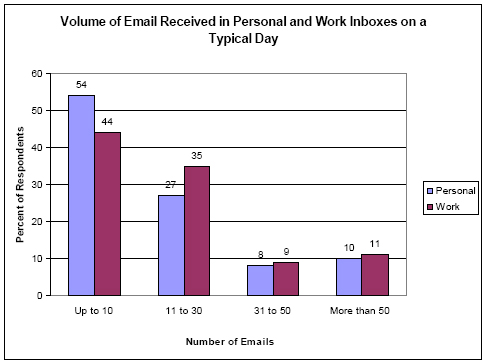
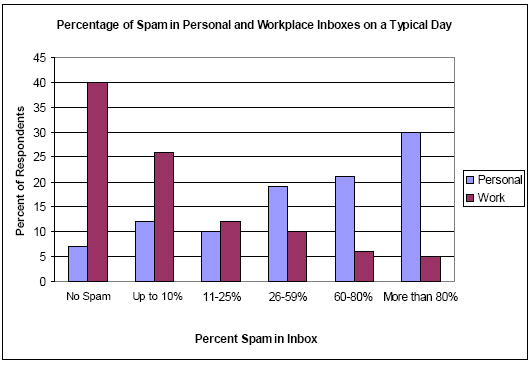
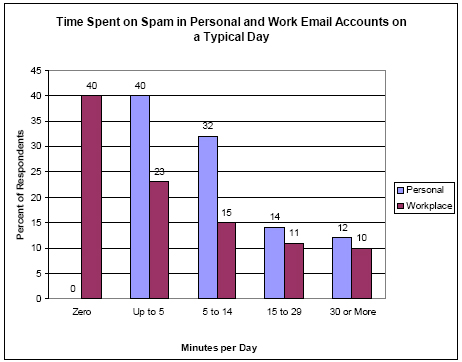
Work email
In this study, as in past studies,6 we found the volume of email that workers process is quite moderate, although a little bit higher than in personal email accounts. Some 44% of those who have a work email account said they receive 10 or fewer emails on a typical day. Another 35% receive between 11 and 30; 9% between 31 and 50; and 11% receive over 50.
A surprisingly small percentage of spam shows up in work email accounts, much less than in personal accounts: 40% of those who receive email in a work account get no spam at all; another 26% received less than 10% spam; a further 12% get up to 25%. Of the remaining 21%, half received over 60% spam in their accounts.
Work emailers spend relatively little time on spam. Some 40% of work emailers spend no time at all on spam. Another 23% spend just a few minutes a day on spam. Another 15% spend from 5 to 14 minutes; 11% spend from 15 to 29 minutes; and 10% spend a half hour or more a day on spam.
We found once again that regardless of the overall volume of incoming email, spam is rather evenly spread through the inboxes of work emailers; the proportions of spam in the inboxes were similar no matter how much email the respondent usually receives. There are two clusters of exceptions to this: Those who received the lowest volume of email, (5 or fewer), received the least amount of spam (51% of those receiving 5 or fewer emails get no spam). On the other extreme, those getting the most email (over 50 per day) also are more likely to get at least 80% spam.
Of those who get spam in their work accounts, 34% say it is sometimes hard for them to get to the messages they want to read.
Why there are differences between home and work
There are several reasons why spam loads in work and personal accounts differ so radically. First, most people’s personal email addresses are more vulnerable to spammers’ basic methods of finding consumers for a number of reasons: the big Internet Service Providers, which provide tens of millions of people their personal email accounts, are popular targets for those who are building lists of email addresses to spam. Also, people generally behave more cavalierly with their personal screennames than their work screennames, posting them on the Web and using them in more places, thereby making them more likely to be harvested by spammers. And finally, the lines of defense against spam are shored up more strongly in many companies, where email systems are closed and where IT professionals install filters and other protective measures against spam. Consequently, less spam gets through. All these are reasons why spam is more likely to be aimed at and to arrive in personal email inboxes.
In work email accounts, spam numbers alone can belie the heart of the story. While both the volume of spam and the time spent on spam in work email accounts look relatively small, that relative “success” against spam comes at a price. The costs and consequences of spam in the work email accounts are often hidden from the average worker.
The stories TRAC received from email users reveal some of those costs and consequences.
- “I am a Lotus Notes Administrator for (a large firm)…I receive on average about 115,000 spam emails per day. There is a three fold problem. The first is the fact that it puts a tremendous strain on our servers, with all the extra email. Secondly, it puts a strain on the size of a user’s mailbox, which then impedes their ability to perform their job. Thirdly, the content of those emails may contain offensive materials, which can cause some of our users to lose their jobs.”
- “I’m responsible for the design and maintenance of the mail system at a 20,000 user ISP in California. After installing spam-detection and filtering software, I’ve learned that approximately 40% of all emails we receive match the characteristics of spam, and it accounts for 13 – 15% of all network bandwidth consumed by our mailserver. Of the 12,000 regular email users here, 1000 of them receive nothing but spam. These statistics make me very angry.”
- “I am the technology manager for a commercial collection agency. Spam has become such a huge issue here that I may have to change our published email address as we are now receiving 2000 -3000 spam mails per day. It is costing our company many dollars in system resources and time spent wading through the junk mail to find the legit mail from clients and potential clients.”
- “I’m the director of Information Systems for my company. This makes me responsible for our email. We are a small company and very distributed. We rely on our email as the primary means of doing business with our clients. On a daily basis we receive close to four thousand email messages. Of those messages, 60% are spam, which our filters are reading through and eliminating as best they can. Some may think that is good but in reality it’s only removing 60% of the spam we receive. 40% or close to a thousand messages are still getting through to people each day. The combination of bandwidth, hardware, software, and labor is costing us between 100 and 500 dollars a day, every day. Since the first of the year, spam has been getting worse with no end in site. . …I am at my wits end for what to do.”
- “Our business spends about 1 hour per day erasing spam messages. At $10 per hour (it costs more than that) the annual cost is $2500 per year. That is not insignificant for a very small business.”
- “I am an Avon representative. I went online and placed a bunch of ads trying to get people to email me about selling Avon. Well I keep getting email with the subject “I just read your ad.” I am thinking they are replying and they are not…I open my email trying to run my Avon business and most of the time it is full of junk.”
For those on the front lines of fighting spam in the workplace and for those paying the bills, there may be comfort in the results from a 2003 survey by the American Management Association measuring positive and negative effects of email in the workplace. Keeping spam at bay in the workplace does largely preserve and protect the value of email for workers: The good effects of email (transmitting information, communicating with far flung colleagues and customers, time to respond.) were all rated positively by at least 60% of respondents. Fewer than 20% of respondents reacted negatively to any bad effects of email: 19% of workers felt they spent too much time on email; 12% felt they spent too much time on spam, the negative effect of email with the lowest response rate.7




